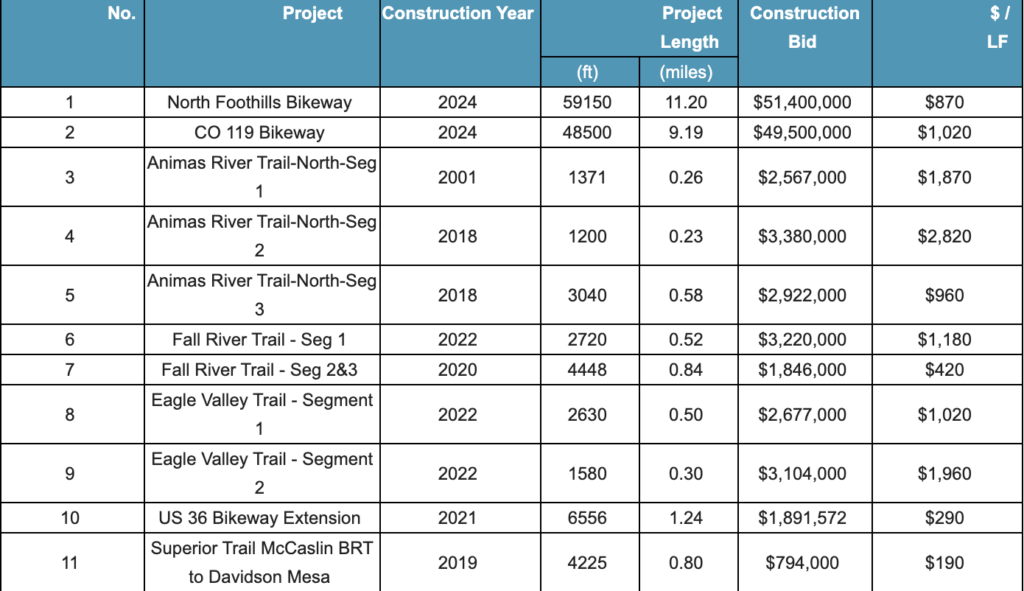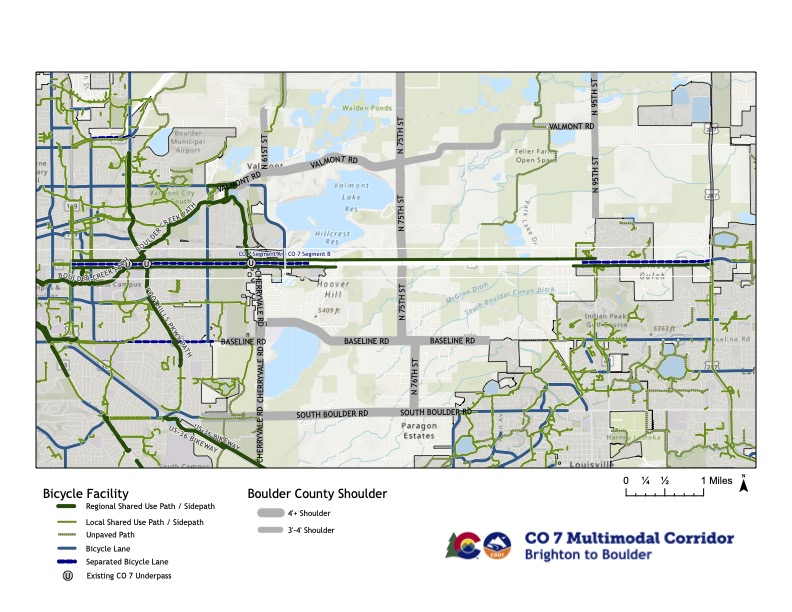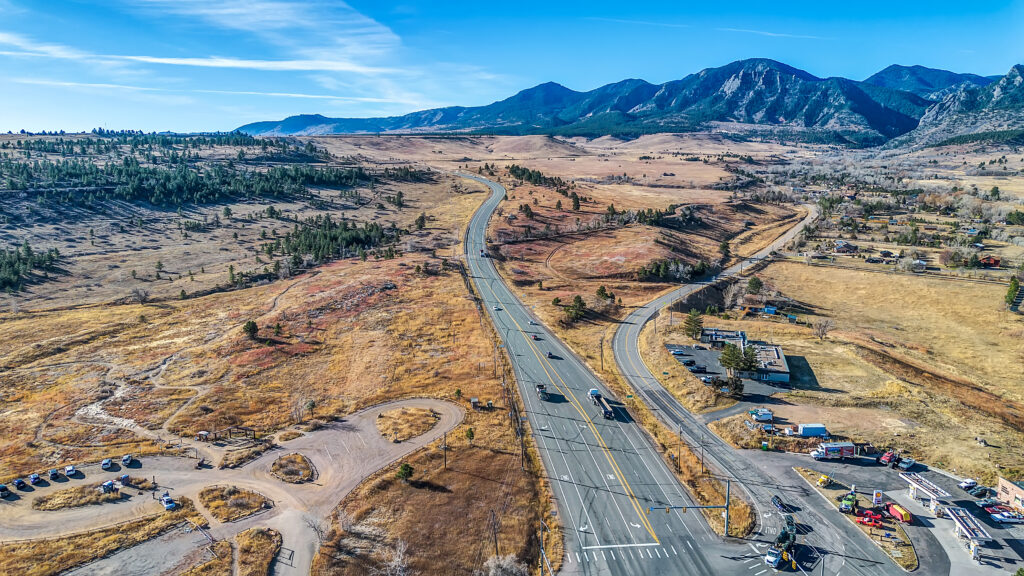~This post may be edited over the remainder of 2024~
C4C’s publishes its program service goals combined with a year-end summary at or near the turn of the year. It also publishes a mid-year update. Here’s the 2024 mid-year update on C4C’s work. It’s a lot to read but, either collectively or individually, the community supports C4C and, in return, C4C attempts to provide transparency.
Infrastructure
The North Foothills Bikeway
“Damn expensive. In the past it would have been built in phases.” This is what C4C’s most expert counsel commented upon hearing the $91 million projected cost. $50-$80M for the 11 mile bikeway. For a public construction project of this magnitude, a contingency cost is added and that results in the $91M figure.
For C4C, the project as a whole is greater than the sum of it’s parts. The bikeway combined with the relatively new transit service and the proposed wildlife crossings connects communities but it does so only as a complete, end-to-end utilization of what is now just a road. It results in a demonstration of a leading standard and what is sometimes called transformative change in transportation.

A conceptual rendering of the North Foothills Bikeway. Note the actual and contraindicated proximity of auto traffic to cyclists as well as two roadside memorials.
Upon consideration, the cost makes sense. Take the below comparative information furnished by Boulder County.


For a really expensive per-mile project, check out the $20M per-mile Peaks to Plains Trail in Clear Creek Canyon where the right-of-way is very constricted by topography.
Construction costs go up and up, that’s one thing and there are two other factors that contribute to the cost.
The first is Boulder County’s stipulation that the path be built as much as possible within the right-of-way (publicly owned land for transportation). The second is that if the resulting facility is not appealing, cyclists will just go back onto the US 36 North Foothills Highway shoulder and the path would be a $30M – $50M waste of money. One cannot, as some have proposed, “just tack on a sidewalk next to the road.”
These variables plus the topography of the right-of-way multiply the difficulty of building. The complex land features in the constrained strip of land make the construction of an appealing path into an engineering challenge, not to mention underpasses and/or intersections which also add cost.
If nothing is done then the costs of adverse safety outcomes speak for themselves. The opportunity for the path to diversify appealing access to a broad range of user is also significant. Another way to think of it is that, under a comprehensive analysis, it would be more costly not to build the path than to build it.
Not included in the above discussion is Boulder County’s wildlife crossing project. If a picture is worth a thousand words, here’s what one of the very highest rates for collisions with animals east of the Divide looks like north of Nelson Road along US 36 North Foothills Highway.

An identified elk herd has been crossing North Foothills Highway for years and causing auto-animal collisions.
An expert analysis would produce one more observation. Oftentimes the true cost of a transportation project is not really communicated to the public. That is, there are parts and pieces that get accounted for in different categories that are not listed. This project is showing the cost up front for a multi-use facility alone, one not tied into a greater roadway project where the accounting can get complicated.
C4C’s goal of bringing up to $3M to the table to incentivize the building of the path from the City of Boulder to Lefthand Canyon Drive, statistically the most dangerous section, is more important than ever. That’s a lot of money for C4C to raise but what has been shown to be true is that if C4C is serious about a project, it’s not enough to complain or comment. C4C has to do the work and bring the cash. Money doesn’t just talk, it turns heads and attracts more money which gets things built.
Highway 119 Boulder – Longmont and Highway 7 / Arapahoe Road
Both of these projects, listed in C4C’s 2024 goals, have good news. The 119 Diagonal Project will break ground this autumn including work on the separated bikeway in the middle of the divided highway. It will be built to above standard criteria with, for instance, multiple under- or overpasses at intersections.

11 years and $135M later, construction begins this autumn.
CDOT’s ten year plus Arapahoe Road/Highway 7 Boulder to Brighton Project is a whopper but, so far, in sections A and B; there are good provisions for bicycling and multi-modal use in general. Upon leaving the City of Boulder, there is a separated path all the way to Lafayette where the bicycling facilities become more appropriate for an urban setting.

Thanks to the Arapahoe Project Team for putting together this map showing the future Arapahoe cycling facilities and their connections to existing cycling facilities.
In the case of the 119 Boulder – Longmont Project and the Arapahoe Project, C4C is leaning towards moving these to the category of “monitoring” since they appear to be proceeding well for Boulder County and for cyclists.
Great work to Boulder County government, CDOT, and many others–nice job!
The “GoBo” Golden – Boulder Highway 93 Bikeway Feasibility Project
C4C’s supporters or even its board of directors roll their eyes back into their heads when they hear how complicated transportation topics can be. Crossing two counties and two regions of CDOT, this is no exception. However, thanks to Bike JeffCo, C4C and Bike JeffCo are making progress on the proposal to donate $450,000 to fund a feasibility study for a separated bikeway between Golden and Boulder along the Highway 93 right-of-way.
C4C has verbal commitments for up to $150,000 towards the project. Boulder County supports the project. Bike JeffCo has secured support from officials in Jefferson County including a significant contribution to funding. Other officials on, for example, the municipal level have voiced either support or openness to the project. Not quite ready to name names yet, C4C is grateful to multiple individuals who have offered their interest in the project.
The board president of C4C has asked C4C’s staff person to begin to tie more specific dates to the timeline of this project which is currently listed generally for 2025. Bicycle Colorado has also taken an interest in both this project and the North Foothills Bikeway. Fingers crossed, a larger coalition can collectively support a leading demonstration of multi-modalism in place of the roadway utilization of right-of-way.

Between Golden and Boulder is currently a no-go zone for most cyclists. A bikeway would fix that and create multi-modal connectivity between communities.
Outreach
Thanks to Don Hobbs, C4C has built a large group of contacts called the Boulder County Cycling Community. A diverse group, one of the tenets of this group is that C4C does not ask for their money, does not ask for their mailing lists, rather, C4C just asks for them to receive occasional communications and maybe join C4C’s mailing list.
Starting soon, C4C plans to bring more structure to the coordination of this group while maintaining its hands-off approach. The idea is to communicate better but still let all the groups maintain their independence.
C4C’s porta-potty program rolls on. It’s a simple and good program that makes a nice difference for small communities that get a lot of cycling traffic.
Policy
Referring to C4C’s stated goals, a lot of credit goes to Bicycle Colorado who was instrumental in, after seven previous attempts, getting a distracted driving bill passed into law that will take effect on January 1, 2025.
Policy is hard to sum up and changes frequently. Here‘s a separate but related post on advocacy.
Scaling the use of SHIFT Driving has gone nowhere. I (Matt) decided to pause that and, instead, substitute two related projects.
Without going into detail, after six years at C4C, there are two things in the policy realm that stand out to me. A statewide standardized crash report system and driver’s certification standards. On the former, the current state is a mish-mash of systems that makes data collection or even more basic things enormously time consuming. The problem is that you “manage what you measure and what you measure matters.” Currently, just measuring crashes in a basic manner is a mess.
The way we measure crashes affects how we think of, talk about, budget for, and act on safety outcomes. Peer industries standardize such fundamental data collection. In critical terms, it most likely costs Coloradans more to leave the system as is than to fix it. Why would we not have a standardized electronic crash report system?
Driver’s certification standards is a tricky topic but another one that Matt is contemplating for improvement. Almost any other similar certification would be substantially more organized. Fixing infrastructure is slow and costly. We could improve our public knowledge of traffic law relatively easily and quickly. Matt has begun to work on this and it will take time.
On another topic, C4C keeps its goal of good multi-modal connections into the mountains in mind but this topic defies any easy steps forward. It’s effectively shelved for the time being until a good and shared way forward becomes evident.
Lastly in policy, thanks to a new C4C board member, C4C has improved relationship with the Boulder County Sheriff’s Office. This is great news. Collectively, we’re really lucky to live in a county where law enforcement weighs its relationships with groups like cyclists in such a thoughtful manner.
The Boulder County District Attorney’s Office is also a crucial partner for C4C. They have a statutory language summary of cycling law on their website. C4C and the Boulder County Sheriff’s Office are working on a paper and online brochure with plain language summaries of cycling and traffic law based partially off of CDOT’s Bicycling Manual.

The Boulder County Sheriff’s Office has demonstrated a genuine interest in partnering on shared solutions for safer cycling in Boulder County.
At the risk of sentimentality, one of C4C’s early supporters was Adelaide Perr. Adelaide was riding north on US 36 North Foothills Highway when a driver pulled out in front of her and she went through the driver’s side window and almost came out the other side of the car. The first two responders on scene were an EMT and a Sheriff’s Deputy.
Government is what we make of it and we’re lucky to live in Boulder County where we can continue to invest in safe and great cycling.

